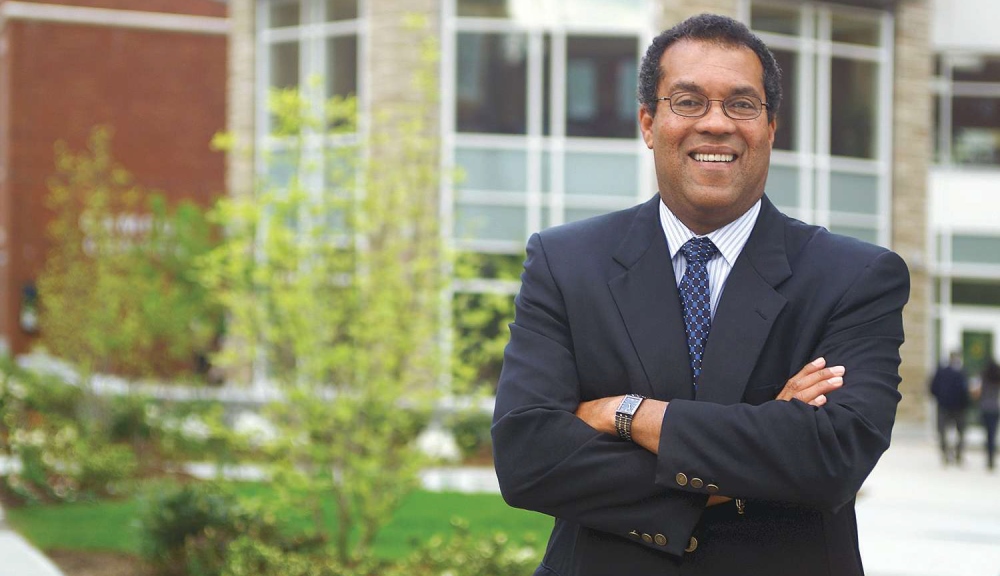John Lott Brown, a 1946 graduate of WPI who worked as a psychologist, educator, administrator, and university president during a long and distinguished career, died Sunday, Jan. 16, 2011, at the age of 86. On the WPI campus, Brown is best remembered for his long service as a WPI trustee and for leading the university as interim president in 1994-95, during a period of transition at the university.
A native of Philadelphia, Brown enrolled at WPI in 1942 through the U.S. Navy's wartime V-12 program. He graduated with a BS in electrical engineering near the end of World War II and completed a year of active Navy duty. He earned a master's in psychology at Temple University and worked briefly for the Link Belt Co. before deciding to return to school. In 1952 he earned a PhD in psychology at Columbia University, where he took over a research program in human factors engineering sponsored by the U.S. Air Force.
In 1954 he was named head of the psychology division in the Aviation Medical Acceleration Laboratory at the Naval Air Development Center, where he helped train astronauts in NASA's Mercury program to perform under conditions of high acceleration. He served simultaneously as assistant professor of psychology at the University of Pennsylvania. Five years later, he joined the faculty of the University of Pennsylvania Medical School full time and in 1962 was named director of the graduate training program in psychology. Brown's research focused on the psychology of the visual system and the senses. He wrote seven chapters on those subjects in a major textbook on psychology.
Brown moved on in 1964 to the University Kansas, where he won appointment as provost. In 1969 he accepted a post as a research professor in the Center for Visual Science at the University of Rochester. He would go on to head the center before being tapped in 1978 to serve as the third president of the University of South Florida, which had been founded just 22 years earlier.
During his decade at the helm of the University of South Florida, Brown oversaw the transformation of the school from a small liberal arts institution to a major research university. During that time the university's annual research funding grew from $14.7 to $23 million, its budget doubled, and its enrollment rose from 23,000 to over 30,000, eclipsing that of Florida State, which had been the second largest public university in Florida.
Brown was a champion of professional programs at the university, creating a medical school, an engineering college, and the Moffitt Cancer Center. The university also introduced 38 new degree programs, opened two branch campuses, and significantly expanded its library holdings during his tenure. Brown is remembered as a visionary leader who built the foundation for the university's later successes.
After stepping down as president, he accepted joint appointments at the university in engineering and medicine with an additional appointment as professor of industrial engineering. He later served as director of the Human Factors Division of the university's Center for Urban Transportation Research, before retiring in 1992. He emerged from retirement the following year to accept the directorship of the Center for Microelectronics Research.
In 1994, after Jon Strauss stepped down as WPI president, Brown was named to a short list of candidates for the post of interim president. The board voted to offer him the position in September, and he accepted immediately. "I didn't have to think about it very long," he said at the time. "I've been involved with WPI for a very long time as a student, an alum, and a trustee. I told them that if they believed me to be the best person for the job, I would, without reservation, accept."
Brown was credited for helping to foster a stronger sense of community at WPI and for building a collaborative working relationship between the faculty, students, and administration. He also launched a faculty-driven project aimed at integrating computer technology more fully into teaching at WPI. His year in office proved a busy one, with the completion of a major renovation of Higgins Laboratories, the mechanical engineering building, the celebration of the 20th anniversary of WPI's first off-campus project center, in Washington, D.C., and the approval by the Worcester City Council of a proposal to close the portion of West Street traversing the campus and turn it into a pedestrian mall.
Brown, who was named a WPI trustee in 1971 and an emeritus trustee in 1983, was honored numerous times by his alma mater. He received the Robert H. Goddard Alumni Award for Professional Achievement in 1969, an honorary doctorate in science in 1984 (the year he also served as Commencement speaker), the William R. Grogan Award (for outstanding contributions in support of the mission of the university) in 1996, and the Herbert F. Taylor Alumni Award for Distinguished Service in 2006. During his year as interim president, he was tapped for Skull, the senior honorary society.
Brown is survived by his wife, Catherine, four children, and six grandchildren. Details on services are pending.

